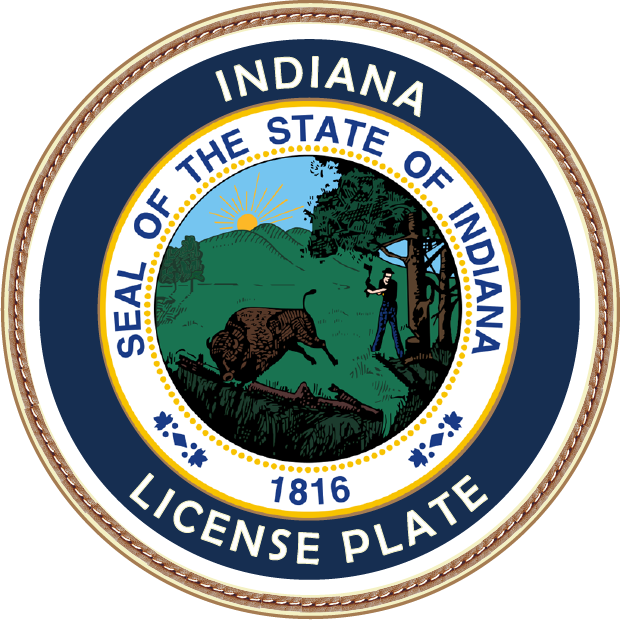Understanding Indiana License Plate Laws
Understanding Indiana's license plate laws is essential for all vehicle owners to ensure compliance and avoid penalties.
This comprehensive guide delves into the intricacies of Indiana's license plate regulations, providing clarity on display requirements, types of plates, and legal obligations.
License Plate Display Requirements in Indiana
Indiana law mandates specific guidelines for displaying license plates on vehicles. According to Indiana Code § 9-18.1-4-4, license plates must be:
- Securely fastened in a horizontal and upright position to prevent swinging.
- Clearly visible and not obstructed by any part of the vehicle or foreign materials.
- Mounted at least 12 inches from the ground, measured from the bottom of the plate.
- Maintained free from foreign materials and in a condition to be clearly legible.
These requirements ensure that license plates are easily readable by law enforcement and other drivers, promoting safety and compliance.
Front and Rear Plate Regulations
In Indiana, most vehicles are required to display only a rear license plate. However, certain vehicles must also have a front plate:
- Tractors
- Dump trucks
- Trucks with a rear-mounted forklift or a mechanism to carry a rear-mounted forklift or implement
These vehicles must display a license plate on the front to ensure visibility, especially when the rear plate may be obscured by equipment.
Sticker Placement and Requirements
Indiana license plates feature stickers that indicate registration details. Proper placement is crucial:
- Top right corner: Year of registration expiration.
- Top left corner: Month and day of registration expiration.
- Bottom right corner: County of vehicle registration.
Ensure that these stickers are affixed correctly and remain unobstructed to comply with state regulations.
Temporary and Interim Plates
Temporary and interim license plates are issued for new vehicle purchases or pending permanent plates. According to Indiana Code § 9-18.1-4-4:
- Display on the rear of the vehicle or affix to the left side of a window facing the rear, ensuring clear visibility and no obstruction.
- Maintain the plate free from foreign materials and in a legible condition.
Failure to properly display temporary plates can result in a Class C infraction.
Types of License Plates Available
Indiana offers a variety of license plate options to cater to different needs and preferences:
- Standard Plates: Issued to most passenger vehicles.
- Personalized Plates: Customizable with chosen characters, subject to availability and approval.
- Special Group Recognition Plates: Support specific organizations, colleges, or causes.
- Military Plates: Honor military service and affiliations.
- Historic Vehicle Plates: For vehicles at least 25 years old, used as collector's items.
Each plate type may have specific eligibility requirements and fees.
Penalties for Non-Compliance
Non-adherence to Indiana's license plate laws can lead to penalties:
- Class C Infraction: For violations such as improper display, obscured plates, or using fictitious numbers.
- Fines: Monetary penalties associated with infractions.
- Vehicle Impoundment: In severe cases or repeated offenses.
Ensuring compliance helps avoid these consequences and promotes road safety.
Maintaining Plate Visibility and Condition
To comply with state laws, license plates must be:
- Clean and Legible: Free from dirt, damage, or wear that obscures information.
- Unobstructed: Not covered by frames, accessories, or materials that hide any part of the plate or stickers.
- Properly Illuminated: Rear plates must be visible from 50 feet at night, requiring functional lighting.
Regular maintenance ensures that plates remain compliant and easily readable.
Special Considerations for Commercial Vehicles
Commercial vehicles, such as trucks with rear-mounted forklifts, have specific requirements:
- Front Plate Display: Mandatory due to potential rear obstructions.
- Secure Mounting: Plates must be firmly attached to prevent swinging or detachment.
- Visibility: Ensure that equipment or cargo does not obscure the plate.
Adhering to these guidelines is crucial for commercial vehicle operators to remain compliant.
Authentic Model Year Plates for Historic Vehicles
- Eligibility: Vehicle must be at least 25 years old and used as a collector's item.
- Display: Authentic plates from the vehicle's model year can be used, provided they were issued by the Indiana BMV in that year.
- Registration: Must carry a Historic license plate and Certificate of Registration in the vehicle at all times.
This option allows enthusiasts to maintain historical accuracy while complying with state laws.
Interactive FAQ
- Q: Do I need a front license plate in Indiana?
- A: Only specific vehicles, such as tractors, dump trucks, and trucks with rear-mounted forklifts, require front plates.
- Q: Can I customize my license plate?
- A: Yes, Indiana offers personalized plates, subject to availability and approval.
- Q: What should I do if my license plate is damaged or lost?
- A: Request a replacement through the Indiana BMV to ensure continuous compliance.
- Q: Are there penalties for obscured license plates?
- A: Yes, obscured plates can result in a Class C infraction and associated fines.
- Q: How often do I need to renew my registration stickers?
- A: Annually, with stickers indicating the expiration month, day, and year.
Conclusion
Staying informed about Indiana's license plate laws is vital for all vehicle owners. Proper display, maintenance, and adherence to regulations not only ensure legal compliance but also contribute to road safety. For more information or specific queries, consult the Indiana Bureau of Motor Vehicles or visit their official website.
